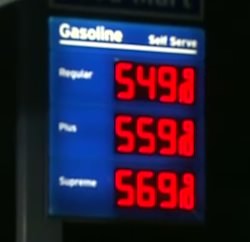Why Have Gas Prices Skyrocketed in California?
Here's some not-so-good news for motorists in the Golden State at the beginning of the workweek: Gas prices in California have soared to record levels, rising 50 cents in the span of seven days. But relief may soon be on the way.
Here’s some not-so-good news for California motorists at the beginning of the workweek: Gas prices in the Golden State have soared to record levels, rising 50 cents in the span of seven days. On Monday, the average price of a gallon of regular gasoline was $4.67, a record high in the state and much, much higher than anywhere else in the country.
So what gives with the higher prices at the pump?
For starters, gasoline in California is usually more expensive than in other places thanks largely to gas taxes in the state that are significantly higher than the national average. Secondly, refineries have to produce higher-quality gasoline to meet California’s air quality standards, so gasoline can’t just be imported from any old pipeline. In fact, there’s little pipeline capacity to bring the product in from other states. As a result, motorists in California pay, on average, 30 to 50 cents more per gallon than do drivers in the rest of the country.
Coupled with some recent refinery and pipeline problems in the state, and you begin to see why some stations are charging more than 5 bucks a gallon.
As James Hamilton at Econbrowser wrote:
California has experienced a series of disruptions to gasoline supplies. The Chevron refinery in Richmond (across the bay from San Francisco) has a normal capacity of 243,000 barrels per day, or 8.5% of the total petroleum products supplied to Petroleum Administration for Defense District 5, of which California is a part. But a fire at the Richmond refinery in August has significantly reduced its production. The Kettleman-Los Medanos pipeline, which carries 85,000 barrels per day of crude oil to the San Francisco Bay Area, has been closed since mid-September due to organic chloride contamination. And on Monday, a power outage shut down ExxonMobil’s 149,000-barrel-per-day Torrance refinery in L.A.
To ease the pain California motorists are enduring, Gov. Jerry Brown on Sunday ordered that refineries be allowed to produce winter-blend gasoline that is normally not available to the state until late October. “If this situation continues, it may cause unacceptable price impacts for consumers and small businesses, significant economic disruption, and serious harm to public safety and welfare,” Brown wrote in a letter to regulators at the California Air Resources Board. “Allowing refiners to make an early transition to winter-blend gasoline could quickly increase fuel supply.”
The move is expected to lower gasoline prices and thus please drivers, though it could have some adverse effects on the environment.
Los Angeles Times:
The cheaper blend usually doesn’t hit the market until Oct. 31. It evaporates more quickly in warm weather than its summer counterpart, making it potentially more damaging to the environment.
But experts said the move could push down prices up to 20 cents in a week, though consumers likely won’t see relief for several days. Even as prices hit new highs, the increases have narrowed, from 17.1 cents Friday to 12.8 cents Saturday, 4.1 cents Sunday and 1.3 cents Monday.
Hamiltion warned, however, that prices could remain high because of consumer demand and a willingness to pay at the pump even when prices have peaked.
The good news is that these kinds of disruptions are by their nature temporary; in fact, the Torrance refinery was back to normal operations by Friday. Based on the current Brent price below $112/barrel, I would expect a long-run average national retail gasoline price of $3.64/gallon, about 15 cents below where it currently is, and an average price in California of $4.04/gallon, about 60 cents below Friday’s price.
On the other hand, sometimes people respond emotionally to this kind of situation. NBC San Diego reported “many rushed to fill up their tanks Friday night for fear of prices soaring again over the weekend.” If enough people do that, it would produce a temporary spike in demand to run up against the temporary drop in supply.
It would also provide an instructive illustration of the economic problems that are introduced if speculators (in this case, California consumers) somehow get the notion that what they should do is buy more when the price is highest.
— Posted by Tracy Bloom.
Your support matters…Independent journalism is under threat and overshadowed by heavily funded mainstream media.
You can help level the playing field. Become a member.
Your tax-deductible contribution keeps us digging beneath the headlines to give you thought-provoking, investigative reporting and analysis that unearths what's really happening- without compromise.
Give today to support our courageous, independent journalists.






You need to be a supporter to comment.
There are currently no responses to this article.
Be the first to respond.